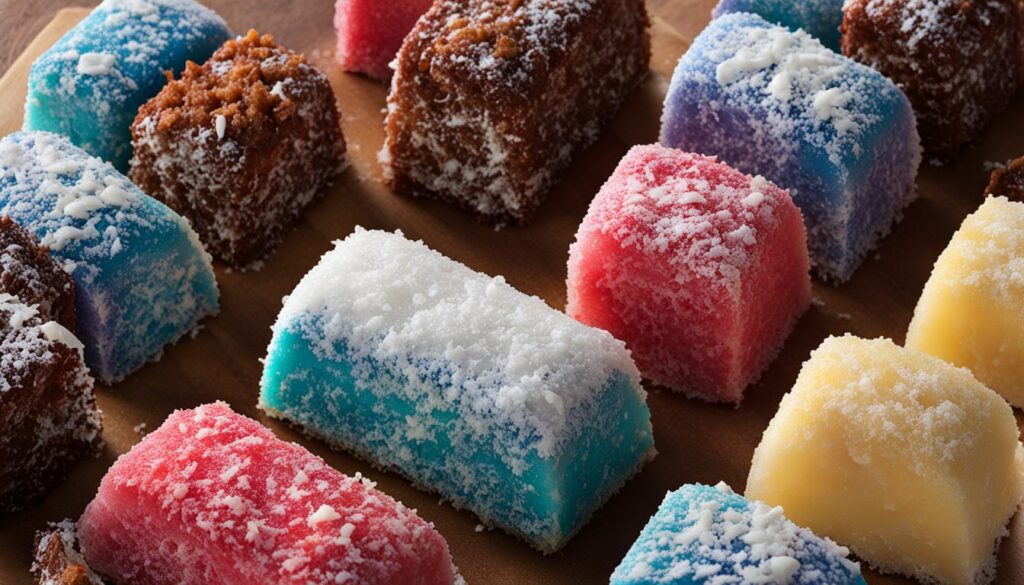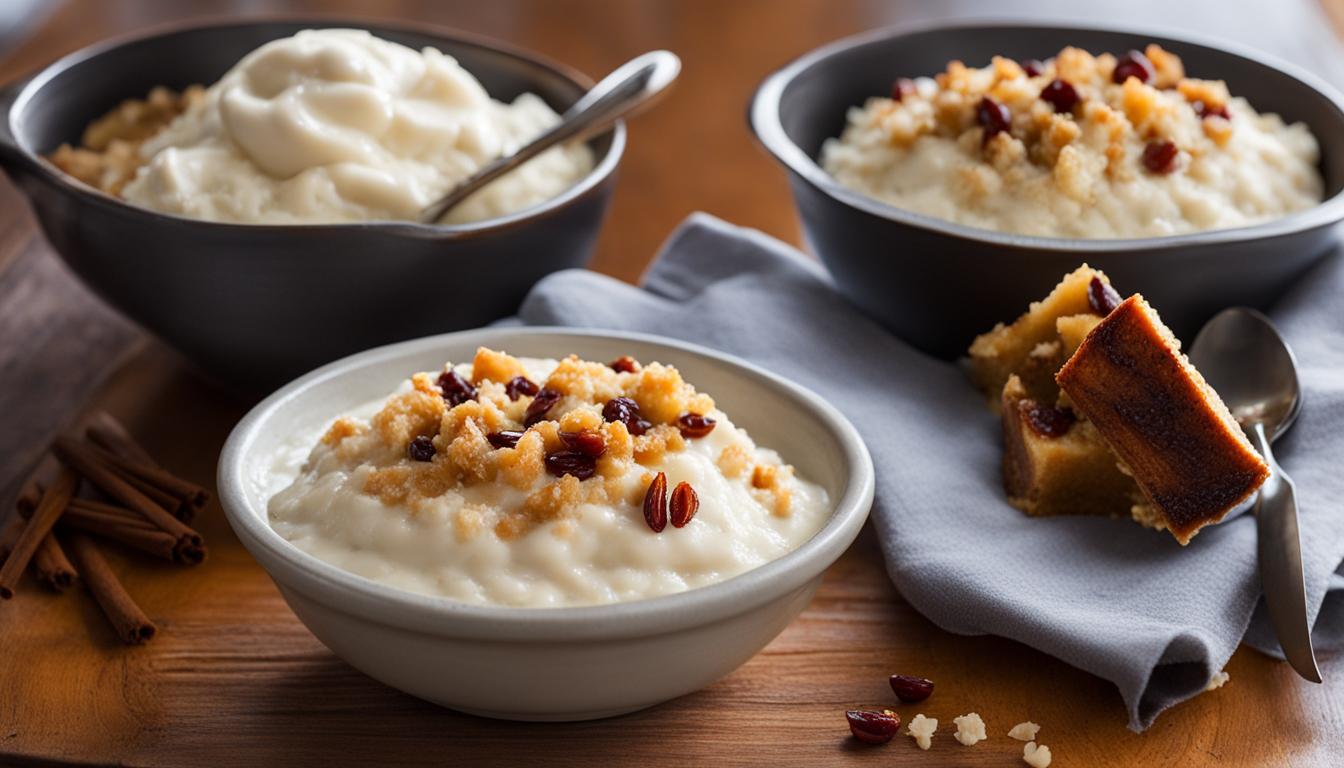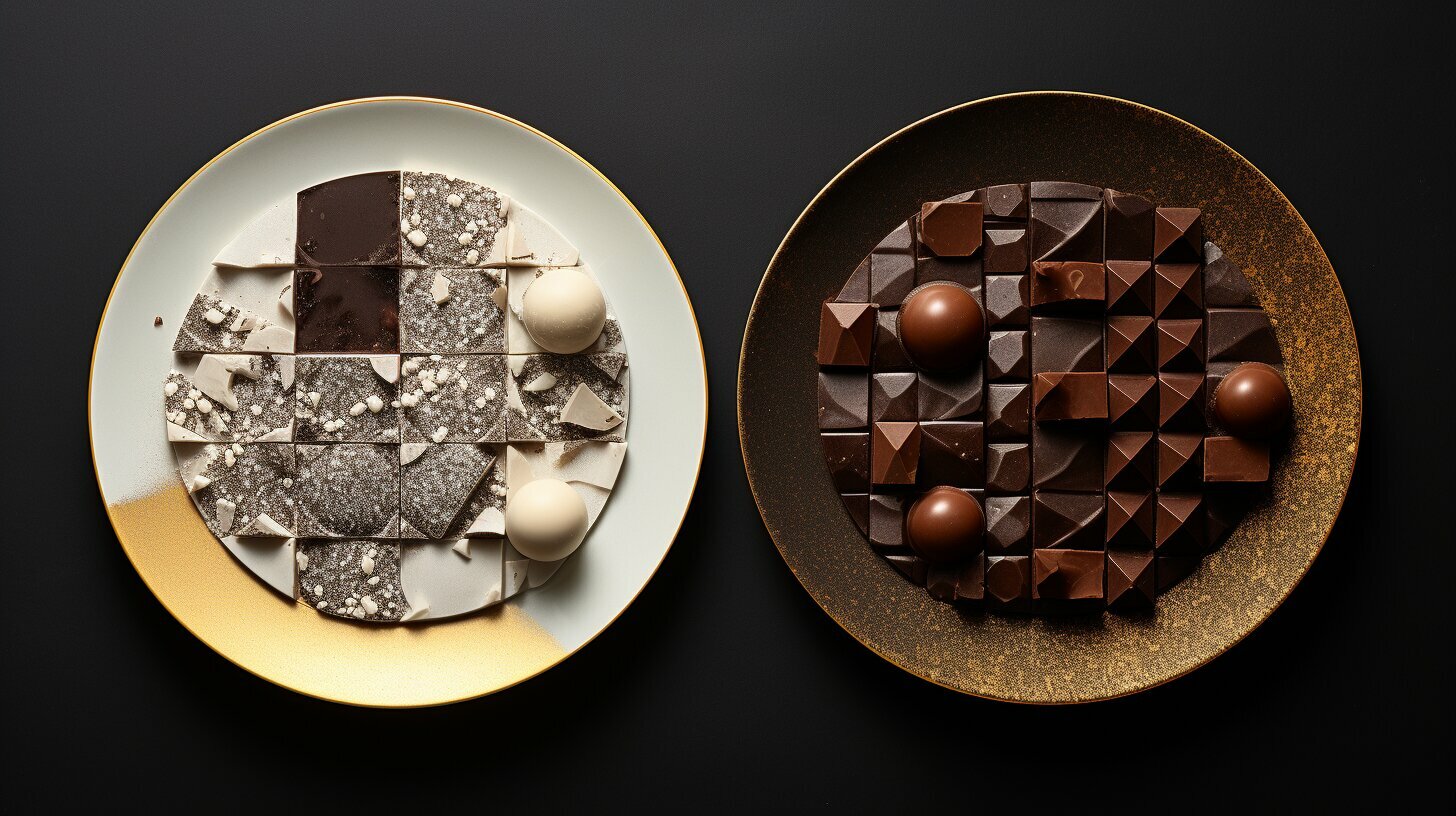Lamingtons and Madeleines are two popular desserts with distinct characteristics. While Lamingtons are square-shaped cakes coated in chocolate or strawberry jelly and rolled in desiccated coconut, Madeleines are small sponge cakes covered in jam and coconut. The differences in shape, coating, and flavor make these treats unique in their own way.
Key Takeaways:
- Lamingtons and Madeleines have different shapes, coatings, and flavors.
- Lamingtons are square-shaped cakes coated in chocolate or strawberry jelly and rolled in desiccated coconut.
- Madeleines are small sponge cakes covered in jam and coconut.
- Lamingtons originated in Australia, while Madeleines have a French origin.
- The ingredients and preparation methods for Lamingtons and Madeleines differ.
Now that we’ve explored the difference between Lamingtons and Madeleines, let’s dive deeper into their origins, ingredients, flavors, textures, and serving styles.
Origin and History
Lamingtons and Madeleines have fascinating origins and a rich history that adds to their appeal. Let’s dive into the background of these delightful desserts.
Lamingtons
The history of Lamingtons can be traced back to Australia in the late 19th century. These iconic treats are named after Lord Lamington, the Governor of Queensland from 1896 to 1901. Legend has it that they were created by his French chef as a way to repurpose stale sponge cake. The chef cut the cake into squares, coated them in chocolate or strawberry jelly, and rolled them in desiccated coconut. Lord Lamington loved these unique creations, and they quickly gained popularity throughout Australia.
Madeleines
On the other side of the world, in France, Madeleines have a history that dates back even further. These small, shell-shaped cakes are believed to have originated in the town of Commercy in the 18th century. They were named after a girl named Madeleine, who allegedly baked them for the exiled king, Stanislaus Leszczyński. Madeleines gained widespread recognition when they were mentioned in Marcel Proust’s novel “In Search of Lost Time,” further solidifying their place in French culinary history.
| Lamingtons | Madeleines |
|---|---|
| Australian origin | French origin |
| Named after Lord Lamington | Named after a girl named Madeleine |
| Created by Lord Lamington’s French chef | Believed to have been baked by a girl named Madeleine |
| Popularized in Australia | Gained recognition through Marcel Proust’s novel |
Now that we know the origins and history of Lamingtons and Madeleines, let’s move on to exploring their delicious ingredients and preparation methods.
Ingredients and Preparation
Lamingtons and Madeleines are both delightful desserts that require a careful selection of ingredients and precise preparation methods to achieve their signature flavors and textures.
Lamingtons Ingredients
The main ingredients for making Lamingtons include:
- Butter
- Sugar
- Eggs
- Flour
- Vanilla extract
- Desiccated coconut
- Chocolate or strawberry jelly for coating
To make Lamingtons, start by mixing the butter and sugar until creamy. Gradually add in the eggs, flour, and vanilla extract, making sure to incorporate them well. Pour the batter into a baking dish and bake until the cake is cooked through. Once cooled, cut the cake into squares or rectangles, and then coat each piece in chocolate or strawberry jelly. Finally, roll the coated cake in desiccated coconut, ensuring it is evenly covered.
Madeleines Ingredients
The key ingredients for Madeleines include:
- Butter
- Sugar
- Eggs
- Self-raising flour
- Vanilla extract
- Jam for brushing
- Desiccated coconut
To prepare Madeleines, begin by creaming the butter and sugar until light and fluffy. Gradually add in the eggs, self-raising flour, and vanilla extract, mixing well. Spoon the batter into dariole moulds or cupcake pans and bake until golden brown. Once the Madeleines have cooled, brush them with your preferred jam and generously coat them in desiccated coconut.

Table: Ingredients and Preparation
| Lamingtons | Madeleines |
|---|---|
| Butter | Butter |
| Sugar | Sugar |
| Eggs | Eggs |
| Flour | Self-raising flour |
| Vanilla extract | Vanilla extract |
| Desiccated coconut | Desiccated coconut |
| Chocolate or strawberry jelly for coating | Jam for brushing |
Lamington Flavors, Madeleine Flavors, Lamington Varieties, Madeleine Varieties
When it comes to flavors and varieties, both Lamingtons and Madeleines offer a range of options to satisfy different preferences. Let’s explore the delicious choices available for these delectable desserts.
Lamington Flavors
Lamingtons come in various flavors, each offering a unique taste experience. The classic flavor is chocolate, with a rich and indulgent cocoa coating that envelops the sponge cake. For those who prefer a fruity twist, there’s the option of strawberry lamingtons, where the sponge cake is covered in a luscious strawberry jelly coating. Vanilla lamingtons provide a more subtle and delicate flavor, perfect for those who enjoy lighter desserts. With these different flavors, Lamingtons offer a versatile range to suit different palates.
Madeleine Flavors
While Madeleines are often flavored with vanilla, there are also other delightful options to explore. Lemon Madeleines infuse the sponge cakes with a refreshing citrusy taste, adding a zing to each bite. For those who enjoy a hint of citrus with a sweeter twist, orange zest Madeleines offer a tantalizing combination of flavors. The traditional vanilla flavor remains a favorite, known for its comforting and familiar taste. With these flavor variations, Madeleines provide a delightful array of choices to satisfy different preferences.
Lamington Varieties
In addition to different flavors, Lamingtons can also be customized with various fillings, coatings, and toppings, creating a diverse selection of varieties. Some popular variations include Lamingtons filled with cream or jam, adding a creamy or fruity surprise to each bite. Lamingtons coated in white chocolate offer a different flavor profile, with a creamy and sweet coating instead of the traditional cocoa or strawberry jelly. Toppings such as chopped nuts or sprinkles provide additional texture and visual appeal. These different varieties allow for creative combinations and personalized choices.
Madeleine Varieties
While Madeleine flavors may vary, the traditional shape and texture remain consistent. However, there are still opportunities for customization and personalization. Madeleines can be served plain, allowing the delicate vanilla flavor to shine through. They can also be dusted with powdered sugar or drizzled with glaze for added sweetness and visual appeal. Some variations include filling the Madeleines with cream or jam, adding an extra layer of flavor. The versatility of Madeleines lies in their simplicity, allowing for subtle variations that enhance the overall experience.
| Lamington Flavors | Madeleine Flavors |
|---|---|
| Chocolate | Vanilla |
| Strawberry | Lemon |
| Vanilla | Orange Zest |
Texture and Taste
When it comes to texture and taste, Lamingtons and Madeleines offer different sensory experiences. Lamingtons have a dense and moist texture, thanks to the sponge cake base that is soaked in chocolate or strawberry jelly. The coating of desiccated coconut adds a unique crunch with every bite. The combination of soft cake and crunchy coconut creates a delightful contrast that is a hallmark of Lamingtons.
On the other hand, Madeleines have a light and fluffy texture. These small sponge cakes are known for their airy crumb and delicate structure. With a subtle sweetness that is not overpowering, Madeleines offer a more refined and delicate taste compared to the rich and indulgent flavor of Lamingtons.
While Lamingtons have a more substantial and satisfying mouthfeel, Madeleines provide a lighter and more delicate eating experience. Whether you prefer the dense and moist texture of Lamingtons or the light and fluffy texture of Madeleines, both desserts offer a unique and enjoyable treat for your taste buds.

Comparison of Texture and Taste
| Lamingtons | Madeleines | |
|---|---|---|
| Texture | Dense and moist | Light and fluffy |
| Taste | Rich and indulgent | Subtle and delicate |
Serving and Presentation
When it comes to serving and presentation, both Lamingtons and Madeleines have their own unique style. Lamingtons are typically cut into squares or rectangles, showcasing the colorful chocolate or strawberry jelly coating and coconut topping. This makes them visually appealing and enticing to enjoy. They are often served as a snack or dessert, paired with a hot beverage like coffee or tea. The combination of flavors and textures in Lamingtons makes them a delightful treat for any occasion.
On the other hand, Madeleines have a more elegant presentation. These small sponge cakes are usually served on their own, displayed on a serving platter or in a decorative box. The simple yet sophisticated appearance of Madeleines adds a touch of refinement to any gathering. They are commonly enjoyed with a cup of tea, allowing you to savor their delicate flavors and light, fluffy texture. The pleasing aesthetics and delicate nature of Madeleines make them a perfect accompaniment to afternoon tea or as a special indulgence.
In summary, Lamingtons and Madeleines offer different serving styles and presentations. Lamingtons are cut into squares or rectangles, highlighting their colorful coating and coconut topping, while Madeleines have an elegant appearance when served on their own. Both desserts can be enjoyed with hot beverages, but Lamingtons are often enjoyed as a snack or dessert, while Madeleines are traditionally associated with afternoon tea. The presentation of these desserts adds to the overall experience and makes them a delightful treat for any occasion.
| Lamingtons | Madeleines |
|---|---|
| Square or rectangular shape | Small sponge-like shape |
| Colorful chocolate or strawberry jelly coating | Jam coating |
| Coconut topping | Coconut covering |
| Often served as a snack or dessert | Traditionally enjoyed with tea or coffee |
Conclusion
In conclusion, Lamingtons and Madeleines are two distinct desserts that offer unique taste experiences. Lamingtons are square-shaped cakes coated in chocolate or strawberry jelly and rolled in desiccated coconut. They have a dense, moist texture and are known for their rich flavors. Madeleines, on the other hand, are small sponge cakes covered in jam and coconut. They have a light and fluffy texture with a subtly sweet taste.
Both Lamingtons and Madeleines have their own origins and histories. Lamingtons originated in Australia and are named after Lord Lamington, while Madeleines have a French origin and are associated with Marcel Proust. The ingredients and preparation methods for these desserts also vary, resulting in their distinct flavors and textures.
When it comes to serving and presentation, Lamingtons are often enjoyed as a snack or dessert, served cut into squares or rectangles. They are paired with a hot beverage and showcase their colorful coating and coconut topping. Madeleines, on the other hand, are traditionally served on their own, displayed on a serving platter or in a decorative box. They are a perfect accompaniment to afternoon tea.
Whether you prefer the richness of Lamingtons or the delicate flavors of Madeleines, both desserts offer a delightful treat for your taste buds. The differences in shape, coating, and flavors make Lamingtons and Madeleines unique in their own way. So, why not indulge in these delightful desserts and savor the delightful flavors they have to offer?
FAQ
What are Lamingtons and Madeleines?
Lamingtons are square-shaped cakes coated in chocolate or strawberry jelly and rolled in desiccated coconut, while Madeleines are small sponge cakes covered in jam and coconut.
Where do Lamingtons and Madeleines originate from?
Lamingtons have their origins in Australia, named after Lord Lamington, the Governor of Queensland. Madeleines, on the other hand, have a French origin and are believed to have been created in the town of Commercy.
What are the main ingredients for Lamingtons and Madeleines?
The main ingredients for Lamingtons include butter, sugar, eggs, flour, vanilla extract, and desiccated coconut. Madeleines are made with butter, sugar, eggs, self-raising flour, and vanilla extract.
What flavors are available for Lamingtons and Madeleines?
Lamingtons come in various flavors including chocolate, strawberry, and vanilla. Madeleines are usually flavored with vanilla but can also be made with lemon or orange zest.
How do Lamingtons and Madeleines differ in texture and taste?
Lamingtons have a dense, moist texture with a crunchy coconut coating, while Madeleines have a light and fluffy texture with a subtly sweet taste.
How should Lamingtons and Madeleines be served and presented?
Lamingtons are typically served cut into squares or rectangles, while Madeleines are traditionally served on their own, displayed on a serving platter or in a decorative box.
 Skip to main content
Skip to main content


